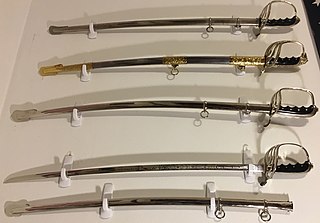 W
WA cutlass is a short, broad sabre or slashing sword, with a straight or slightly curved blade sharpened on the cutting edge, and a hilt often featuring a solid cupped or basket-shaped guard. It was a common naval weapon during the early Age of Sail.
 W
WA Mameluke sword is a cross-hilted, curved, scimitar-like sword historically derived from sabres used by Mamluk warriors of Mamluk Egypt after whom the sword is named. Egypt was, at least nominally, part of the Ottoman Empire and the sword most commonly used in Egypt was the same as used elsewhere in the empire, the kilij.
 W
WThe Model 1832 foot artillery sword was a 25-inch (64 cm) short-sword with a straight, double-edged blade and brass-mounted leather scabbard.
 W
WThe Model 1840 noncommissioned officers' sword was adopted by the United States military in 1840. Based primarily on a sword used by the French Army, the model 1840 NCO proved somewhat heavy hilted and ill balanced. For over 70 years, it was widely used by the Army; today its usage is restricted to ceremonial occasions. The sword had a 31-inch blade, a cast brass hilt resembling the more expensive wire-wrapped leather grips, and a leather scabbard rather than the steel used by cavalry troopers and officers, although some makers, such as Emerson and Silver, issued a steel scabbard rather than leather to protect from wear. Leather scabbards were phased out beginning in 1868.
 W
WThe Model 1840 Cavalry Saber was based on the 1822 French hussar's sabre. Unlike its replacement, the Model 1860 Light Cavalry Saber the M1840 has a ridge around its quillon, a leather grip wrapped in wire and a flat, slotted throat. It is 44in long with a 35in blade and weighs roughly 2.5 lbs.
 W
WThe Model 1860 Light Cavalry Saber is a long sword made of steel and brass, used by US cavalry from the American Civil War until the end of the Indian wars; some were still in use during the Spanish–American War. It was 41 inches (104 cm) long with a 35 by 1 in blade and weighed 2 lb 4 oz (1.0 kg) alone or 3 lb 10 oz (1.6 kg) with iron scabbard.
 W
WThe Model 1902 Army Officers' Saber is the current sword used by officers of the United States Army. The official nomenclature for the current regulation U.S. Army saber is “saber for all officers, Model 1902”. It was adopted on July 17, 1902 by authority of General Order No. 81. The M1902 saber was authorized for all officers, both infantry and cavalry, with the exception of Chaplains. The lightly curved blade measures between 30 and 34 inches long with weights initially specified by the U.S. Army to be between 20.2 and 22.8 ounces and a point of balance of 3.25 inches from the hilt as specified for infantry sabers.
 W
WThe Model 1913 Cavalry Sword, commonly referred to as the Patton Saber, was a cavalry sword designed for the U.S. Army by Second Lieutenant George S. Patton in 1913. Patton suggested the revision from a curved sword and edge and cutting technique to a thrusting style of attack, following his extensive training in France.
 W
WThe Marine Corps noncommissioned officer's sword is a sword worn by noncommissioned officers (NCOs) and staff noncommissioned officers (SNCOs) of the United States Marine Corps. The NCO sword was adopted in 1859 and is patterned after the United States Army's foot officers' sword of 1850. The M1859 NCO sword continues service today as the Marine Corps drill and ceremonial sword. The sword's use is restricted by regulation to ceremonial occasions by an NCO or Staff NCO in charge of troops under arms or at weddings and wedding receptions where at least one of those being married is in uniform and has the rank of Corporal or higher.
 W
WUSMC Sword Manual Procedures are commonly used in the Marine Corps. Marines considered Non-commissioned Officers (NCO) as well as Staff Non-Commissioned Officers (SNCO) may find themselves having to perform "Sword Manual", which is a stationary drill.
 W
WThe West Point Cadets' Sword is issued to cadet officers of the United States Military Academy at West Point, New York for wear when the uniform is designated as "under arms," to include formal functions, drill, parades, inspections and graduation. The swords are issued to cadets in their First Class (4th) year, and are returned to the Academy upon separation, although Cadets have the option of buying their saber or purchasing a newly made one. Despite its straight blade and lack of a knuckle guard, it is referred to by USMA staff and cadets as a "saber," likely because the commands for its manual of arms utilize that term as the command of execution